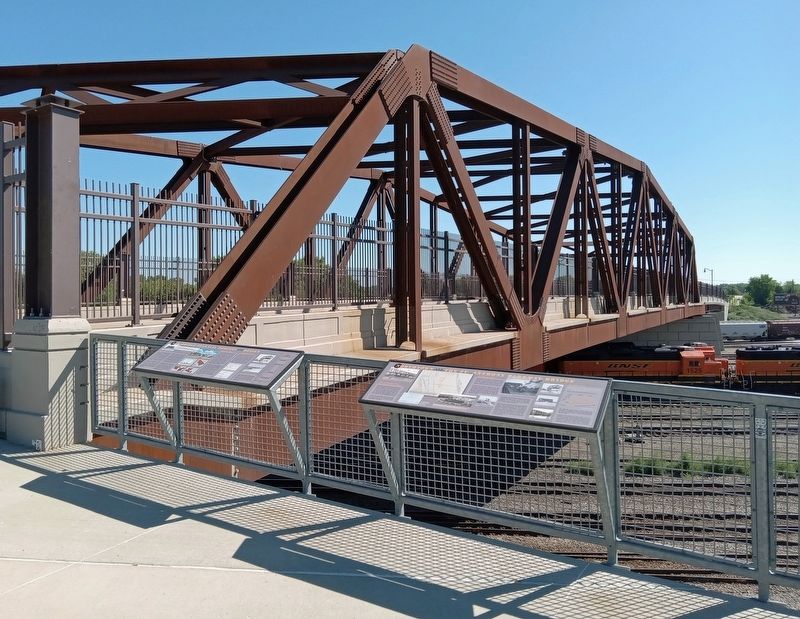Marshall Terrace in Minneapolis in Hennepin County, Minnesota — The American Midwest (Upper Plains)
Northtown and the St. Anthony Parkway Bridge
The first bridge at 33rd Avenue N.E. (1911) before dismantling, June 1925 (NP Archives, MHS)
Crossing Northtown Yard: The St. Anthony Parkway Bridge
Three bridges have spanned the wide expanse of the Northtown Yards below St. Anthony Parkway. The first was completed in 1911 by the Northern Pacific Railway to carry what was then 33rd Avenue N.E. over its new Northtown rail yard. Grade separation was desired by Minneapolis residents, because the city's many railroad grade crossings were the scene of bad accidents, first involving pedestrians and horse-drawn vehicles, and then automobiles and trucks.
The four Howe through truss spans rested on timber piers and carried an 18'-wide roadway. This bridge was considered temporary, and was initially planned for replacement in five years.
This 1914 map shows the Northern Pacific Railway's new brick roundhouse, yards, and shops. Brickyards lined the east side of the river, some were served by rail spurs.
Northern Pacific Railway. "Overhead Bridge 33rd Avenue N.E." General Plan and Location Plat, March 13, 1925. (NP Archives, MHS)
Northern Pacific turntable at Northtown, 1948. (Ron V. Nixon Collection, Museum of the Rockies)
The 1925-26 Bridge
The Northern Pacific built a replacement bridge in 1925-26. The new structure was designed to carry increased St. Anthony Parkway traffic, and heavier loads. New construction standards required by the State of Minnesota required that through truss roadway bridges in the state use riveted connections.
The bridge was a five-span structure, with a length of 533'-6". Each span was a Warren through truss with verticals assembled with riveted connections. The trusses were placed 37' apart, center to center, with roadway traffic carried between the trusses, and a sidewalk cantilevered on the south. The bridge was skewed 27 degrees to minimize impact to the rail operations below.
Bridge under construction, March 10, 1926, looking west.
NP Engine 1534 leaving Northtown, St. Anthony Parkway Bridge at rear, ca. 1927. (Ron V. Nixon Collection, Museum of the Rockies)
The Northern Pacific Railway Engineering Department designed the bridge, with M.F. Clements as Bridge Engineer. Fort Pitt Bridge Works in Pittsburgh supplied the steel, and local contractor N.W. and W.A. Nelson Company erected it.
More than 75 years later, the Burlington Northern Santa Fe Railway (BNSF) owned the bridge when the structure required replacement due to its age and condition. At this time it was eligible for the National Register of Historic Places for
its engineering significance and its relationship to the Minneapolis Grand Rounds and Great Northern and Northern Pacific railroad corridor historic districts. This historical significance was considered in planning the new structure.
Riveting Span #1, March 10, 1926, looking north.
St. Anthony Parkway Bridge, August 23, 1926, looking east.
The bridge in 2014.
The Warren Truss
"The rigid-connected Warren through truss was popular among American railroad engineers for the economy of its detailing and the stillness of its webs."Bridge No. 90664, Minnesota Historic Bridge Inventory forms, 1997
Diagram of a Truss Bridge
By 1900, the Warren truss, a truss bridge type patented in England in 1848, was frequently used for steel highway bridges in Minnesota, especially for long spans.
A metal truss bridge uses many small pieces, or members, to make a beam long and strong enough to span distances. The individual components are connected in a series of triangles. Each truss member is either in compression or tension, and connections at the panel points can either be bolted or riveted.
Topics. This historical marker is listed in these topic lists: Bridges & Viaducts • Railroads & Streetcars. A significant historical year for this entry is 1911.
Location. 45° 1.649′ N, 93° 16.139′ W. Marker is in Minneapolis, Minnesota, in Hennepin County. It is in Marshall Terrace. Marker is at the intersection of St. Anthony Parkway and California Street NE, on the right when traveling east on St. Anthony Parkway. The marker is at the Northtown Railyard Overlook. Touch for map. Marker is in this post office area: Minneapolis MN 55418, United States of America. Touch for directions.
Other nearby markers. At least 8 other markers are within one mile of this marker, measured as the crow flies. New Bridge Planning Process and Design (here, next to this marker); Columbia Park and Golf Course (here, next to this marker); Park Planning and the Grand Rounds (here, next to this marker); Prairie to Brickyard: The Landscape of Northtown (a few steps from this marker); Carl Ripken, Sr. (approx. ¼ mile away); MLB ★ Minnesota Twins Rod Carew All★Star Field (approx. ¼ mile away); Marshall Terrace (approx. 0.3 miles away); Land Use (approx. one mile away). Touch for a list and map of all markers in Minneapolis.
Credits. This page was last revised on March 18, 2024. It was originally submitted on March 8, 2024, by McGhiever of Minneapolis, Minnesota. This page has been viewed 43 times since then. Photos: 1, 2. submitted on March 8, 2024, by McGhiever of Minneapolis, Minnesota. • J. Makali Bruton was the editor who published this page.

